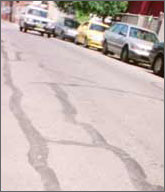Road Maintenance

In NSW, between 2001-2005, 929 motorcyclists were injured and 14 were killed in crashes associated with road surface hazards. These included 21% of all single vehicle crashes and 26% of crashes on curves.
Consistent levels of skid resistance are fundamental to a motorcycle's stability. Non-motorcyclists often fail to appreciate that sudden changes in the road surface need involve only a very small portion of an otherwise good road to be dangerous.
This is because most of the braking and steering control for a motorcycle are through the front wheel, but power is through the rear wheel. A sudden changes in the road surface can be sufficient to cause a momentary loss of traction and destabilise the motorcycle. If this happens while the rider is braking or changing direction, the risk of skidding increases.

Changes to the road surface are a particular problem when the rest of the road is in good condition, because they are unexpected and the rider may not notice until it is too late.
A single pothole, patch of sand or water, oil or early morning dew on a painted road marking or tar jointing compound can be sufficient to cause a skid. Loose gravel on a sealed surface contributed to 14% of the riders injured and 13% of those who died in crashes on curves

Perhaps the most common complaint by riders is about the steel plates used as temporary covers over road trenches. The RMS has issued specifications for the skid resistant friction coating to be used on these plates. The problems with these plates is not just the slippery nature of the steel, it is also how they are installed.
Comman hazards for motorcyclists are created by a sudden change in road surface caused by:
- A pothole
- Gravel or other loose material
- Oil, grease, diesel etc
- Repaired patches
- Rubberised tar crack sealant
- Water seepage or ponding

